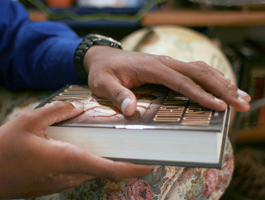home | north bay bohemian index | news | north bay | news article

Photograph by Gabe Meline
OUT OF HIS HANDS: The teen, pictured at home, says nerve damage lingers as a result of the March 31 incident.
Danger Zone
Unanswered questions remain for the family of a teen beaten by police—and a lawsuit may be on its way
By Leilani Clark
John Jones saw the yellow police tape that wrapped around a back area of Elsie Allen High School and immediately knew that something was wrong. He stopped his car and got out, asking the police for details, worried sick after reporting his grandson missing the night before. "When you see that tape," he says, nearly two months later, "you think somebody must've died."
But Jones' 17-year-old grandson wasn't dead. Seriously injured and lying in a hospital bed, he'd been beaten in an altercation during which he'd helped send three and possibly four police officers to the hospital with minor injuries. Jones picked up his wife and drove straight to Santa Rosa's Memorial Hospital, unprepared for the sight of their grandson lying sedated and tied to a gurney with two police guards standing over him.
"He looked like he had been dragged across the asphalt, road rash from his face to his chin," says Kathy Parkinson-Jones, the teen's grandmother. When she touched his arm, it was swollen and hard from nerve damage. His kidneys were failing. "He was beaten so badly," she says, "that the toxins overloaded his kidneys and liver."
On Sunday evening, a doctor sat down with Parkinson-Jones and said that her grandson was in critical condition and that he might not survive. Friends were turned away from visiting the injured teen. The grandparents—the teen's legal guardians—had to use a code word at the visitor's desk to get into his room.
After three weeks of hospitalization, the boy has been recuperating at home, free from the dialysis that marked the days following the incident. But questions remain about what exactly happened that night behind the high school. Despite multiple requests, the minor's legal guardians have been unable to obtain a copy of the police report, forcing them to wonder why the police hit the teen with strength enough to cause kidney failure; why the missing persons report was unchecked, even though it was filed at 1:30am, nearly three and a half hours before the incident; and why the Press Democrat reported that a knife had been drawn ("Teen pulls knife on officers during Santa Rosa altercation"), when a detective on the case told them that it fell out when the teen's hands were forced from his pockets. "They've been dragging their feet and telling us different things," Jones says.
At this point, the family may have to take legal action to get the answers. They are currently consulting with a lawyer and gathering evidence for a possible police-brutality case. In the meantime, an internal criminal investigation is underway, headed by Sgt. Steve Fraga of the Santa Rosa Police Department's violent crime investigations team. The findings will be delivered to the district attorney upon completion, but when, exactly, is unclear; at press time, repeated calls to Sgt. Fraga had gone unanswered.
According to Jones and his wife, their grandson was possibly having a "break with reality," disoriented and trying to find a way home on the night before March 31. At approximately 5am, an area resident called police to report a "suspicious subject" yelling at passing cars, walking on the caller's porch while talking loudly and, at one point, throwing an object at a passing car. The police say that the African-American teen was "uncooperative and noncompliant with officers' requests for identification," but at least one witness is saying that they heard the teen say, "I did what you told me, what do you want?," according to Jones. Two sheriff's deputies and additional police officers were called in for backup, totaling at least six officers on the scene, according to a police press release.
With no independent civilian review board in Sonoma County, the process of getting the facts from the SRPD and the Sonoma County Sheriff will potentially pose a challenge. "The police are saying one thing. The neighbors are saying one thing. And our grandson is saying another thing," Jones says, clearly frustrated.
Now, the teen spends his days in home school, unable to graduate with his 2011 class. He rides with his grandmother to doctor appointments, takes high blood pressure pills and gathers the energy to play rugby again. The police have yet to return his cell phone or his wallet, and he still has pain from the incident in his fingers, which may have some nerve damage.
As the family search for answers to how their grandson went from a missing person to a dangerous suspect in the course of a few minutes, their disillusionment grows.
"The police are supposed to be protectors," says Parkinson-Jones, adding that she's trusted law enforcement for over 50 years. "They blew that all to hell as far as I'm concerned."
For his part, Jones says that if his grandson were white, things would have turned out much differently. "As far as the beating, race had a part of it," says Jones, evoking the high-profile killing of Jeremiah Chass, who was shot 11 times by officers, beaten and stripped in 2007. "Coming from the history that I know about and the problems that African Americans have in this town, it's not surprising what happened to my grandson."
The family's legal action, says Jones, is meant not to avenge their son's injuries, but to "stop the cycle." He adds that he doesn't want other teens to go through what his grandson went through. "He came pretty close to getting killed," Jones says, "just for trying to get home."
|
|
|
|
|
|